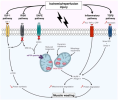Eddy Edson
Well-Known Member
- Relationship to Diabetes
- Type 2
Prompted by a recent thread to finally record a vent about this ...
Since diagnosis I have been steadily increasing my walking step count to the point where I'm now up to average 18K+ per day. This is tons of walking, really a ton-an-a-half for somebody like me with occlusive PAD, and I don't think it would be unreasonable to hope that it might be at least protective against common age-related muscle loss.
No such luck. In my most PAD-affected leg I have wastage and weakness in the lower calf and ankle. PAD is definitely the culprit. The mechanisms are less clear but probably have to do with muscle-damaging stresses caused by ischemia and reperfusion - lack of blood flow followed by restoration - due to the PAD. There are a bunch of possible mechanisms associated with this. Eg:

(From https://www.ncbi.nlm.nih.gov/pmc/articles/PMC7432591/ )
When you see that kind of complicated picture it's probably a fair guess that nobody has a very clear idea about the implications for clinical practice. And this is the case here. Eg: there are mechanistic and animal-model reasons for thinking that at some point additional exercise might actually be muscle-damaging for somebody with PAD. Maybe that's the case for me, or maybe my situation would be worse if I wasn't doing this much exercise. I have found no vascular specialist, exercise physiologist, PAD/artery researcher who can answer this question (which they all think is interesting). All of the research and studies focus on people who do very little exercise, for whom any increase is naturally beneficial.
Anyway, I've started adding in some resistance work with an exercise physiologist & I'll see how that goes over the next few months.
It's also worth noting that PAD is generally a fairly likely explanation for otherwise unexplained lower body muscle wastage.. It's a common but underdiagnosed condition, for which diabetes is a big risk factor, and it's often quite asymptomatic (particularly in the absence of much walking).
Since diagnosis I have been steadily increasing my walking step count to the point where I'm now up to average 18K+ per day. This is tons of walking, really a ton-an-a-half for somebody like me with occlusive PAD, and I don't think it would be unreasonable to hope that it might be at least protective against common age-related muscle loss.
No such luck. In my most PAD-affected leg I have wastage and weakness in the lower calf and ankle. PAD is definitely the culprit. The mechanisms are less clear but probably have to do with muscle-damaging stresses caused by ischemia and reperfusion - lack of blood flow followed by restoration - due to the PAD. There are a bunch of possible mechanisms associated with this. Eg:

(From https://www.ncbi.nlm.nih.gov/pmc/articles/PMC7432591/ )
When you see that kind of complicated picture it's probably a fair guess that nobody has a very clear idea about the implications for clinical practice. And this is the case here. Eg: there are mechanistic and animal-model reasons for thinking that at some point additional exercise might actually be muscle-damaging for somebody with PAD. Maybe that's the case for me, or maybe my situation would be worse if I wasn't doing this much exercise. I have found no vascular specialist, exercise physiologist, PAD/artery researcher who can answer this question (which they all think is interesting). All of the research and studies focus on people who do very little exercise, for whom any increase is naturally beneficial.
Anyway, I've started adding in some resistance work with an exercise physiologist & I'll see how that goes over the next few months.
It's also worth noting that PAD is generally a fairly likely explanation for otherwise unexplained lower body muscle wastage.. It's a common but underdiagnosed condition, for which diabetes is a big risk factor, and it's often quite asymptomatic (particularly in the absence of much walking).
Last edited:
